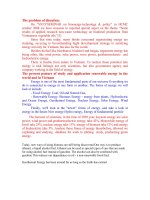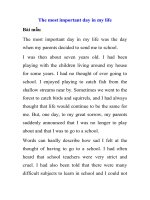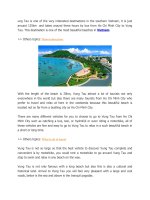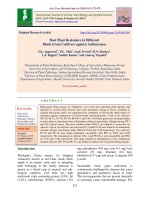Host plant resistance in different black gram cultivars against anthracnose
Bạn đang xem bản rút gọn của tài liệu. Xem và tải ngay bản đầy đủ của tài liệu tại đây (131.35 KB, 5 trang )
Int.J.Curr.Microbiol.App.Sci (2019) 8(3): 571-575
International Journal of Current Microbiology and Applied Sciences
ISSN: 2319-7706 Volume 8 Number 03 (2019)
Journal homepage:
Original Research Article
/>
Host Plant Resistance in Different
Black Gram Cultivars against Anthracnose
S.K. Aggarwal1*, B.L. Mali1, Amit Trivedi1, R.N. Bunker1,
L.S. Rajput2, Sudhir Kumar3 and Anurag Tripathi4
1
Department of Plant Pathology, Rajasthan College of Agriculture Maharana Pratap
University of Agriculture and Technology, Udaipur-313001, Rajasthan, India
2
Division of Plant Pathology, Indian Agricultural Research Institute, New Delhi, India
3
Division of Plant Biotechnology, ICAR-IIPR, Kanpur- 208024, Uttar Pradesh, India
4
Department of Agriculture, Sharda University, Greater Noida-201306, Uttar Pradesh, India
*Corresponding author
ABSTRACT
Keywords
Black gram,
Anthracnose,
Resistance, Percent
disease Index and
Moderately resistant
Article Info
Accepted:
07 February 2019
Available Online:
10 March 2019
Black gram [Vigna mungo (L.) Hepper] is one of the most important grain legumes and
attacked by several foliar diseases that cause premature drying of leaves, resulting in
reduced black gram yields. An experiment was conducted to find out the stable source of
resistance against Anthracnose (Colletotrichum lindemuthianum). Total of six cultivars
(PU-30, PU-31, PU-38, PU-40, PUI-94-1 and TAU-1)of Black gram were evaluated under
in micro plots in Agronomy farm at Rajasthan college of agriculture, Udaipur during 2013
and 2014 kharif season. The most virulent isolate (MVL) was utilized to screen the six
cultivars. Out of six cultivars, two cultivars PU-31 and PU-30 were found to be moderately
resistant with per cent disease index (PDI) of 28.40 and 31.40 respectively. Two cultivars
PU-38 and PU-40 were found moderately susceptible with PDI of 39.60 and 42.90
respectively. The remaining two cultivars TAU-1 and PUI-94-1 were susceptible with PDI
of 47.20 and 51.40 respectively. The study resulted in identification of two moderately
resistant cultivars (PU-30 and PU-31) can further be utilized in resistant breeding program.
Introduction
Blackgram [Vigna mungo (L.) Hepper]
commonly known as urd bean, mash, black
maple is an annual, semi erect to spreading
herb belonging to the family fabaceae is
grown as a kharif crop in tropical and subtropical countries. Urd bean has high
nutritional value containing protein (24%), fat
(1.4%), carbohydrate (59.6%), calcium (154
mg), phosphorus (385 mg), iron (9.1 mg), beta
carotene (38 mg), thiamine (0.4 mg),
riboflavin (0.37 mg) and niacin (2 mg) per 100
g seeds.
Sustainable black gram cultivation is
continuously challenged by diseases that cause
quantitative and qualitative losses in yield.
The microorganisms that are present internally
or externally cause considerable damage. The
571
Int.J.Curr.Microbiol.App.Sci (2019) 8(3): 571-575
major
diseases
viz.,
Anthracnose
(Colletotrichum lindemuthianum), Bacterial
leaf
blight
(Xanthomonas
phaseoli),
Cerccospora leaf spot (Cercospora canescen)
and Corynespora leaf spot (Corynespora
casslicolli), Powdery mildew (Erysiphe
polygoni), Root rot and Web blight
(Rhizoctonia solani) and Stem canker
(Macrophomina phaseolina) are reported in
this crop. Among these Anthracnose, Web
blight and Powdery mildew causes heavy
losses to the crop.
Majid (1953) reported the Green gram
anthracnose first time in India from Jorhat of
Assam state in 1951.Anthracnose of
Blackgram is caused by fungus C.
lindemuthianum which attacks on all aerial
plant parts and at all the stages of plant
growth. Symptoms are circular, black, sunken
spots with dark centre and bright red orange
margins on leaves and pods. The yield losses
caused by black gram anthracnose are
proportional to the disease severity and vary
remarkably depending on the stage of
infection, genotypes and environmental
conditions.
In India, anthracnose of black gram was
earlier considered to be of minor importance
but with intensification of black gram
cultivation its severity has gradually increased.
The pathogen particularly under cool and
humid environmental conditions, resulting in
80 to 100% yield losses (Sharma et al.,
2007).Limited work has been done to breed
resistant varieties and fungicidal control is
largely practiced.
However, host plant resistance is more ecofriendly and effective as it also will also
reduce utilization chemicals as fungicides
control is hazardous for soil as well as not
economic for farmers. The present study was
conducted to identify the resistance against
anthracnose disease as resistant cultivars are
the best and eco-friendly to manage a disease.
Materials and Methods
Isolation
Disease samples were collected from different
places i.e. Mavli, Fatehnagar and RCA farm
Udaipur, where urd bean is grown extensively.
Diseased samples were carefully placed in
polythene bags, properly tagged and brought
to the laboratory. Isolations of the pathogen
were attempted from infected urd bean leaves
of all samples. The infected leaves were
thoroughly washed in running tap water to
remove the adhering soil. Diseased portions
were cut into small pieces along with
adjoining healthy area with the help of a
sterilized scalpel, washed in sterilized water,
surface sterilized by dipping in 0.1 per cent
mercuric chloride solution 1:1000 (HgCl2) for
one minutes followed by rinsed thrice with
sterilized distilled water and then transferred
on two per cent potato dextrose agar (PDA)
medium in Petri plate under aseptic conditions
in laminar air flow. These were incubated at
28±2°C at least for 5 to 7 days for growth of
the fungus. Fungal growth appeared in two to
three days as white to grayish white. Sub
cultures from uncontaminated periphery of the
mycelial growth by hyphal tip culture method
were made on PDA slants after 3-4 days.
Identification of fungus
Cultural characters of all isolates were studied
by growing them on PDA medium. The
identification of the fungus was done by
comparing the morphological characters and
reproductive structures of different isolates
with binocular compound light microscope
under laboratory conditions. The sporulating
cultures were examined and identified on the
basis of detailed morphological characters of
somatic and reproductive characters up to
species level with the help of standard
description (Barnett and Hunter, 1972 and
Holliday, 1980) as characterized from the
initial cultures of the single conidium.
572
Int.J.Curr.Microbiol.App.Sci (2019) 8(3): 571-575
Multiplication of pathogen
For artificial inoculation of anthracnose
pathogen (C. lindemuthianum), most virulent
isolate (MVL) multiplied separately on
autoclaved sorghum grains. The sorghum
grains were soaked overnight in water and
washed with tap water. About 150 g grains
were filled in polyethylene bags and
autoclaved at a pressure of 1.045 kg cm-2 for
one hour. The growth of the pure culture of
each isolate was aseptically homogenized in
10 ml sterile water with a sterilized needle.
Whereas 5 ml of homogenized culture was
used for inoculating each polyethylene bag
with their respective isolates. Inoculated bags
were incubated at 28±2°C and after five days
these bags were shaken manually every
alternate day to obtain uniform distributed
fungal growth on sorghum grains. After
fifteen days, the profuse fungal growth and
sporulation were washed with distilled water
and filtered through muslin cloth, the spore
suspension so obtained was used for
inoculations of plants for creating disease in
micro plots. The spore suspension strength (1x
103spore/ml) of most virulent isolate was
sprayed on plants after 30 days of sowing.
Spray Inoculation technique for host plant
resistance
On the basis of Pathogenicity and disease
aggressiveness, The Mavli isolate of C.
lindemuthianum was found to be most virulent
and used in screening different six Blackgram
cultivars viz., PU-30, PU-31, PU-38, PU-40,
PUI-94-1 and TAU-1 were evaluated under
inoculated conditions in micro plots. The
pathogenic culture was inoculated on different
cultivars to find out the resistant cultivars
under field conditions.
Inoculation of different cultivars
For multiplication of most virulent isolate of
C. lindemuthianum having strength of 1x103
spores per ml was prepared. This inoculum
was sprayed on six different cultivars of black
gram with five replications of each cultivar.
After appearance of lesions on the leaves the
PDI was gradually recorded up to maturity on
the 0-5 disease rating scale (Table 1). The
observations for per cent disease index were
recorded after 10 days of inoculation on a
standard 0-5 disease rating scale for different
6 black gram cultivars.
Results and Discussion
Among the six cultivars (viz; PUI-94-1, TAU1, PU-40, PU-38, PU-30 and PU-31) PUI-94-1
exhibited (51.40 to 28.4) disease severity in
decreasing order during 2013 respectively.
Similarly in 2014, although the disease
severity was slightly increased with (55.0 to
28.55) per cent in decreasing order
respectively in each variety. In 2013the
maximum mean PDI of 51.40and, which was
more prone to anthracnose disease followed
byTAU-1 with mean PDI of 47.2. The black
gram variety PU-40 exhibited mean PDI(42.90
and PU-38 with mean PDI of 39.60 with
moderate susceptibility reaction.
PU-30 and PU-31 cultivars found to be
moderate resistant with mean PDI of 31.20
and 28.40 respectively. In 2014, PU-30 and
PU-31 cultivars found moderate resistant with
mean PDI of 29.33 and 28.55 respectively.
The two variety viz; PU 40 and PU 38
exhibited moderate susceptibility against
anthracnose of black gram. TAU-1 and PUI94-1 showed susceptibility against this disease
with 49.33and 55.0 Percent disease severity
(PDI) respectively.
The host Plant resistance study 6 black gram
cultivars evaluated, among 6 cultivars PUI-941cultivar showed maximum PDI 51.40 which
was found to be more prone to anthracnose
and PU-31 showed minimum PDI 28.40
which was found least prone to anthracnose
(Table 2).
573
Int.J.Curr.Microbiol.App.Sci (2019) 8(3): 571-575
Table.1 Resistance scale on the basis of PDI mean value is listed below
S.No.
1.
2.
3.
4.
5.
PDI Range
0% to 20%
21% to 35%
36% to 45%
46% to 70%
More than 70%
Reaction
Resistant
Moderately Resistant
Moderately Susceptible
Susceptible
Highly Susceptible
Table.2 Disease severity and reaction of most virulent isolate (MVL) of Colletotrichum
lindemuthianum on different black gram cultivars
S.No.
1.
Black gram
cultivars
PUI-94-1
2.
3.
4.
TAU-1
PU-40
PU-38
47.20(43.3)
42.90(40.9)
39.60(39.0)
49.33 (44.62)
43.5 (41.27)
41.67 (40.2)
5.
PU-30
31.20(33.9)
29.33(32.79)
PU-31
SEm±
CD (P = 0.05)
CV(%)
28.40(32.2)
0.52
1.62
2.33
28.55 (32.95)
0.54
1.72
2.37
6.
Disease severity/
(PDI)* 2013
51.40(45.8)
Disease severity/
(PDI)* 2014
55 (47.87)
Pooled mean
48.26 (43.96)
43.20 (42.20)
40.63
(39.9)
30.26
(33.34)
28.47 (32.57)
0.53
1.67
2.35
53.20(46.83)
Disease
Reaction
(S)
(S)
(MS)
(MS)
(MR)
(MR)
*Mean of three replications, Figures in parentheses are arcsine transformed values
We had evaluated six cultivars of Blackgram
in the present However, Pathania et al.,
(2006) evaluated forty nine common bean
lines comprising of exotic accessions and
locally
grown
cultivars
against
Colletotrichum lindemuthianum exhibited
differential resistance to its races in Himachal
Pradesh, a north-western Himalayan state of
India. Some exotic accessions like G 2333,
Cornell 49242, PI 207262, Mexique 222, TO,
Perry Marrow, Kaboon and Widusawere
resistant to more than five Indian races,
whereas two Indian accessions KRC-5 and
Hans showed resistance to six and four races,
respectively. Kiryakov (2009) studied
virulence diversity of
Colletotrichum
lindemuthianum, the causal agent of the bean
anthracnose; an expedition was undertaken to
6 locations in the Rhodope Mountain. Race
22 was the most frequent (45.8% of the
isolates). This race was virulent to the
cultivars 'MDRK', 'Perry Marrow' and
Widusa'. Races 6 (26.5%) and 2 (17.6%),
came next in frequency. similarly, Rajesha et
al., (2010) conducted field trials to elucidate
the reaction of Dolichos bean genotypes to
anthracnose (Colletotrichum lindemuthianum)
under conditions of natural infection.
Deshmukh et al., (2012) conducted a field
experiment in rabi 2008 to screen five
varieties and thirty-nine germplasms of Indian
bean against anthracnose. Out of these, three
varieties Kapasi, JNP-4, Katargam and two
germplasms NWP8 and NWP21 showed
574
Int.J.Curr.Microbiol.App.Sci (2019) 8(3): 571-575
resistant reaction against anthracnose while
fifteen germplasms viz., NWP12, 19, 20, 22,
24, 25, 26, 27, 28, 29, 30, 32, 35, 37, 39 were
found to be moderately resistant, whereas
variety NPS1 was found highly susceptible to
anthracnose of Indian bean (Lablab purpureus
L) under south Gujarat conditions.
Colletotrichum lindemuthianum in the
Rhodope
Mountain,
Bulgaria.
Rasteniev'dni Nauki, 46:330-334.
Majid, S. (1953). Annals Report of
department of agriculture, Assam for
year ending 31st March 1950. II, The
Grow More Food Campaign, 11:107.
Pathania, A., Sharma, P.N., Sharma, O.P.,
Chahota, R.K., Ahmad, B. and Sharma,
P. 2006. Evaluation of resistance
sources and inheritance of resistance in
kidney bean to Indian virulence of
Colletotrichum
lindemuthianum:
evaluation of resistance in bean to
anthracnose. Euphytica, 149:97-103.
Rajesha, G., Mantur, S.G., Ravishankar, M.,
Shadakshari, T.V. and Boranayaka, M.
B. 2010. Screening of dolichos bean
(Dolichos lablab L.) genotypes for
resistance to anthracnose disease caused
by Colletotrichum lindemuthianum.
International
Journal
of
Plant
Protection, 3:135-136.
Sharma, P.N., Padder, B.A., Sharma, O.P.,
Pathania,
A.
and
Sharma,
P.(2007.Molecular Plant Pathology
Laboratory, Department of Plant
Pathology, CSK HP Agricultural
University,
Palampur,
India.
Australasian Plant Pathology, 36:191–
197.
In conclusion, the study revealed that there
was different type of disease reaction
according to host genotype. The black gram
cultivar PU-30 and PU-31 can be utilised
further in resistant breeding programme.
References
Barnett, H.L., and Hunter, B.B. 1972.
Illustrated genera of imperfect fungi
Burgess Publication Lt. d, St. Paul,
Minnesota, USA, Pp. 241.
Deshmukh, A.J., Mehta, B.P., Sabalpara,
A.N., and Patil, V.A. 2012. Screening
of Indian bean (Lablab purpureus L.)
varieties/germplasms
against
anthracnose
(Colletotrichum
gloeosporioides Penz. and Sacc.) under
field
conditions.
Journal
of
Biopesticides, 5:50-52.
Holliday, P., 1980. Fungal disease of tropical
crops, Cambridge University Press,
Cambridge, U.K., P.250.
Kiryakov, I., 2009. Virulence diversity of
How to cite this article:
Aggarwal, S.K., B.L. Mali, Amit Trivedi, R.N. Bunker, L.S. Rajput, Sudhir Kumar and Anurag
Tripathi. 2019. Host Plant Resistance in Different Black Gram Cultivars against Anthracnose.
Int.J.Curr.Microbiol.App.Sci. 8(03): 571-575. doi: />
575







![Generation mean analysis for yield, yield components and MYMV disease scores in blackgram [Vigna mungo (L).Hepper]](https://media.store123doc.com/images/document/2020_01/09/medium_kiu1578565010.jpg)

